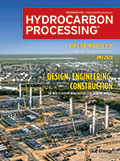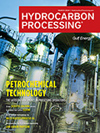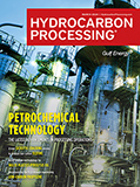
December 2019
Special Focus: Plant Design, Engineering and Construction
The Stone Age did not end due to a stone shortage. The Conventional Oil Age was not eclipsed by vanishing traditional oil and gas resources. The Shale Revolution unleashed an era of abundant, new unconventional oil and gas supplies.
Dividing wall column (DWC) modeling was conducted to apply to natural gas liquids (NGL) fractionation to find if there were any benefits in the design. Regarding the convergence of a unique column with an internal dividing wall, a search was conducted for commercial simulation software that would be applicable.
Maintenance and Reliability
The Petronor oil refinery is in the north of Spain and is part of REPSOL Group. In 2019, the facility upgraded the driver of a reformer’s draft fan from a general-purpose steam turbine and gearbox to a variable frequency drive (VFD) electric motor.
During a normal turnaround and inspection (T&I) of a hydrocarbon sphere, a fatigue failure in the 24-in. inlet pipe riser was discovered. As per the original 2003 design, the sphere serves as a surge tank during pipeline scraping, as well as a backup for a stabilizer during T&I. Each stabilizer has a capacity of 78,000 bpd. However, due to asymmetry in the piping configuration, the sphere typically receives higher flow of 90,000 bpd, with rates sometimes reaching 110,000 bpd as a result of scraping or other activities happening concurrently. The sphere was upgraded to work continuously in 2012 to handle the anticipated additional condensate by adding an overhead gas compressor and a dedicated condensate shipper pump.
Environment and Safety
As environmental regulations are becoming more stringent on reduced nitrogen oxide and carbon monoxide emissions, burner designs are changing to meet revised regulations. The heater design must complement the chosen burner for optimal performance. Although design duty is considered to be the main focus of the heater design, the range of heater operation and its impact on heater safety and emissions needs are often neglected.
ANSI/ISA-84 is one of the most influential standards in functional safety and has been a driver for instrumented process safety improvements over the last 20 yr. It is a comprehensive norm covering a wide range of aspects related to functional safety in process industries, including the entire life cycle of designing, implementing and operating safety systems.
HP Top Project Awards 2019
The editors of <i>Hydrocarbon Processing</i> have identified nine projects that are anticipated to significantly impact the global or regional downstream industries. The winners and nominees of the HP Top Project awards will have a considerable impact on the HPI, whether through CAPEX, satisfying domestic or regional demand, diversifying product offerings, or adding to the resurgence in refining and/or petrochemical processing capacity.
IMO 2020
Gasifiers take the bottom of the crude barrel and move the residue into the C1 value chain. Refiners have had a variable record of running gasifiers for a time and then shutting them down. Reasons for this include inexperience with gasifier operations, lack of knowledge on how to extract profits from the C1 value chain and market difficulties in catering to clients operating in different business environments.
When Kitack Lim won his second, four-year term as the Secretary General of the International Maritime Organization (IMO) in November 2018, it solidified the organization’s aggressive 2020 deadline for a global < 0.5% sulfur limit on fuel oil used onboard ships. This reduced sulfur requirement, commonly known as IMO 2020, squeezes the oil and gas industry, confounding the medium- and small-size refineries that struggle to produce low-sulfur fuel oil (LSFO), and wracking the nerves of maritime freight shippers facing volatile fuel pricing.
The year 2020 will be a mess from the fuel oil stability and compatibility points of view. The year will be price-driven, so the temptation to “cut corners” is great—meaning that a highly variable number of blend components to manufacture the fuel oil will open a “Pandora’s box” of complex and questionable fuel formulations.
Heat Transfer
The authors’ company has been serving the process industry for more than 35 yr to improve tube-side heat transfer in tubular heat exchangers. Its main application area is the use of a proprietary tube insert technology in new equipment design for exchangers with laminar tube-side flow, where considerable size reductions are achievable due to the increased tube-side performance.
Columns
As the hydrocarbon processing industry (HPI) moves into the next decade, three regions will be the leaders in new capital construction—Asia, the Middle East and the U.S.
All the book learning in the world will fail if we do not use common sense. We could also say that we need to think things through and should recognize that intuitive logic can lead us astray. If that sounds like semantic banter, let us zero in on three practical field examples that illustrate the issues at hand.
Hydrogen market demand is forecast to expand. Bulk petrochemicals, ammonia, methanol and gasoline refining consume nearly two-thirds of global hydrogen demand.
Petrochemical companies face significant commercial pressure to offer high-quality products at competitive prices. To boost operational efficiency and support regulatory compliance, many businesses operating in the petrochemical sector use informatics tools, such as laboratory information management systems (LIMS), to organize their data.
Rotating equipment repair vendors are looking at a future that can be described as both exciting and challenging. As predictive maintenance (PdM) makes deeper inroads, vendors have been forced to rethink their legacy repair offerings.
No doubt exists that the added connectivity that modern control and automation systems deliver offers a myriad of benefits. By embedding computing within the process and utilizing edge and cloud technologies, it can provide greater visibility. It creates a digital thread for the plant and allows both equipment and the processes to be analyzed, as well as giving prescriptive advice.
When I talk to professionals in the refining and petrochemical businesses, they are always interested in how new technologies can improve operational efficiency, make plants safer and increase profitability.
Achieving effective catalyst regeneration requires a process that produces a very high level of heat in a very efficient manner. Over the years, several different approaches have been taken to create this required heat. Traditional steam has been a popular choice, as has heated transfer media. However, these methods have limitations.
Trends and Resources
According to <i>Hydrocarbon Processing’s</i> Construction Boxscore Database, more than 400 new projects have been announced in 2019. The total represents a 25% increase in new project announcements year-over-year.
Industrial construction projects are becoming larger and more complex, with shorter schedules. To meet these challenging requirements, such construction projects are often executed by multiple entities located in different countries that may have different business objectives.

- Renewable fuels project in Canada begins production 4/19
- Jet fuel demand growth lags as air traffic exceeds pre-pandemic level 4/19
- Jet2.com to use SAF at London Stansted Airport 4/19
- Neste and New Jersey Natural Gas target reducing greenhouse gas emissions with Neste MY Renewable Diesel 4/19
- Cepsa and Evos join up for green methanol storage in Spain and the Netherlands 4/19
- Russia's Bashneft oil company installs anti-drone nets to protect refineries 4/19




